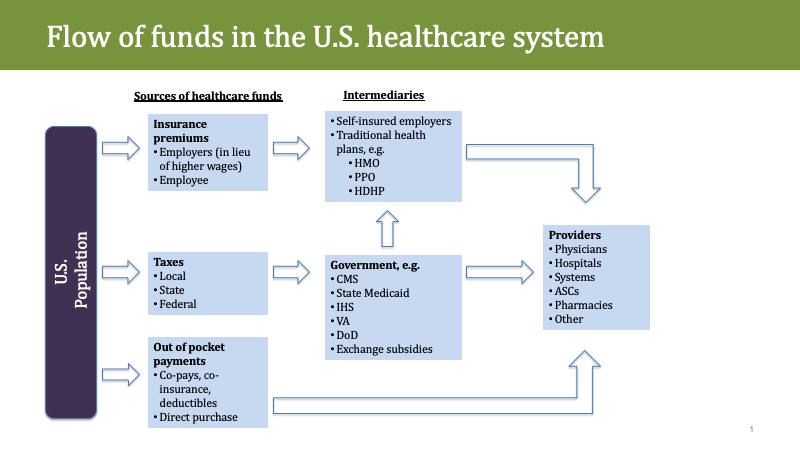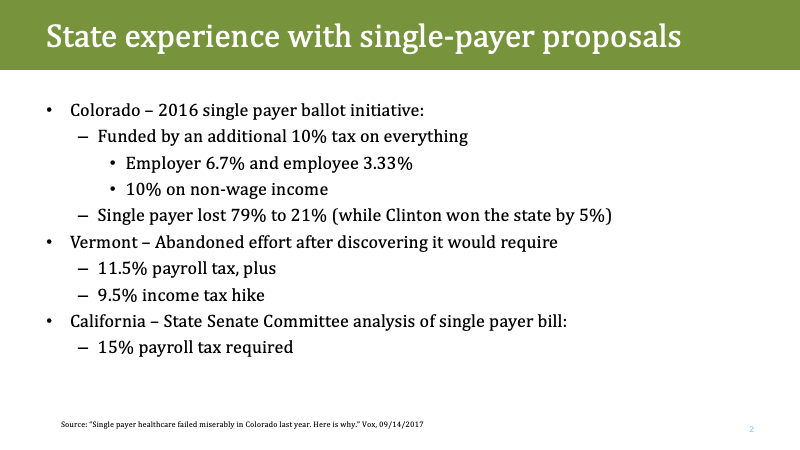About a week ago, a group of progressive Democrats unveiled their latest plan for Medicare-for-all. While we wholly support universal coverage, we also have a number of concerns about this, and other Medicare-for-all proposals. We have previously outlined some of these concerns, but the latest developments seem to warrant a follow up discussion.
First, it seems like it may be beneficial to go back to some basics, specifically, a) what is the purpose of insurance and b) who/how should we pay for universal coverage. It appears that, as a country, we have largely lost sight of both items.
So, let’s start with the first, what is the purpose of insurance? It appears that in any sector (other than perhaps healthcare), the purpose of insurance is to protect/provide coverage against unexpected and primarily catastrophic events. We would be hard-pressed to find car or home insurance policies that cover routine items like oil changes or house painting. Instead, the policies focus on big ticket items like collisions, fires, floods, etc. While some individuals choose to purchase additional coverage for appliances or major repairs, basic car and home owners insurance cover truly ‘catastrophic’ events. And yet, when it comes to healthcare we have come to expect coverage from A to Z (although, ironically enough, the traditional Medicare program, does not have catastrophic coverage and 4 out 5 beneficiaries have supplemental policies to close this gap). If we truly aspire to provide universal health insurance coverage, it would behoove our elected leaders to start by providing basic catastrophic coverage to all (in fact, such a provision was included in the 2017 Cassidy-Collins proposal), rather than trying to push through a fully comprehensive package that would force them to use up all of their political capital AND break the county’s bank in the process.
And on that note, this latest proposal goes beyond even current traditional Medicare by offering to cover all expenses for all healthcare and medications. There would be no out of pocket payments by anyone. Non-government insurance would cease to exist, it would not be needed. This sounds very appealing to many. Yet, this proposal (and many others like it), fail to provide any detail on how much this new program will cost nor from whom the money will come. A quick digression, if we may, although many elected officials and the media like to talk about ‘free healthcare’, healthcare is not free, we are all paying for it in one way or another (see exhibit 1, the flow of funds in U.S. healthcare). So, whatever the final price tag might be, WE are all on the hook to pay for it.

Now, there are a number of ways that WE could pay for universal coverage (including the items shown in the above exhibit), but the ones that have been proposed thus far, include additional payroll and income taxes. It may be of interest to those pushing forward the latest proposal to learn from the experiences of Vermont, Colorado and California (see exhibit 2) and pressure test their assumptions.

They might also take note of how quickly the support for single-payer healthcare dwindles, when citizens are faced with the prospect of higher taxes or with the fact that people would lose their private health insurance coverage (see slides 5 and 9 in particular in Public Opinion on Single-Payer, National Health Plans, and Expanding Access to Medicare Coverage by the Kaiser Family Foundation).
And if the arguments above do not suffice, the skeptics among us, may be convinced by the opinion of the Nobel prize winning economist, Paul Krugman, on why single-payer is not a feasible goal for the U.S.:
- “…single-payer would require a lot of additional tax revenue – and we would be talking about taxes on middle class, not just the wealthy…”
- “Finally, and I suspect most important, switching to single-payer would impose a lot of disruption on millions of families who currently have good coverage through their employers.”
The math behind Krugman’s “most important point” on why single payer is hard to implement in the U.S., is not complex (as exhibit 3 below highlights). Whether the move to single-payer is based on our current traditional fee for service version of Medicare, or on the new proposal for a vastly enriched Medicare-for-all program, it has a number of implications:
- 181 million people will lose their employer provided private insurance. Of course, not all of them will be opposed to an insurance-for-all option. Currently, the need to consider COBRA coverage or be temporarily uninsured acts as a barrier to employees who increasingly want to be much more mobile. So while we don’t think Medicare-for-all is the best pathway there, we (and others) strongly support universal healthcare insurance that is not tied to employment, but rather owned by individuals.
- Another 20.4 million individuals currently enrolled in Medicare Advantage Plans (i.e., private insurance options within Medicare) will find their choices of private plans would cease.
- And 65 million people in Managed Medicaid (i.e., Medicaid benefits administered by private payers) will find their care disrupted.

Another key argument we often hear from single payer advocates is that we need single-payer because ‘other countries achieve universal coverage that way.’ In our latest blog, we have already alluded to the fact that there are many ways to get to universal coverage that have been used by other countries. Moreover, even countries with single-payer coverage (e.g., Australia, Italy, U.K., Canada – although the latter is not even true single-payer), have a supplemental private insurance market (see table 1 here), highlighting the fact that single-payer does not all healthcare problems solve.
Given the culture and history of the U.S., a more politically feasible and fiscally responsible proposal for universal coverage would be to extend the Federal Employee Health Benefit Program (FEHBP) to all U.S. citizens. Even single-payer advocates like Alexandria Ocasio-Cortez recently tweeted about how great her congressional insurance is. We believe that the ‘You Get What We Have’ would be readily embraced by the American public across the political spectrum, and legislation could require that all participating insurers are non-profit (click here for an overview of the FEHBP).
It should be stressed that the large dollar contribution from self- insured entities(Mayo) would go away and have to be made up for by taxing individuals. I hope you can get the ear of Klobuchar and other sensible candidates.
Tony Smithson
Tony, thank you for the suggestion! Sent to Klobuchar and others.
Two other significant concepts to consider as a part of this debate include the issue of personal responsibility/incentive to maintain health (I.e. what role if any am I accountable for in maintaining my own health? While we know individuals have no control over certain diseases, the opposite is also true. Should society pay extra for those unwilling to maintain there own health?) and what are the likely implications on the providers and quality of care. One payer will inevitably drive down reimbursement to providers; while this might be good on many fronts, it is also likely to disincentive some from going into health care professions which will then exacerbate access, further rationing, etc. Look to countries like China and Russia. This then leads back to private alternatives and the circle continues. Thanks for keeping a rational and facts based dialogue going on this very important topic. Political headlines do not appear to be driving us towards a better solution.
I like you analogy to home and auto insurance. To that end, there are a growing number of incentives in auto an home insurance that allow for significant discounts – drive better or build smarter – get a discount. This simply must be allowed in health insurance – we must market healthy behavior. Imagine a “vanishing deductible” in a health insurance policy for good health.
Your summary is clear and concise–I will pass it on to others. The impact on the provider community under the Medicare for All proposal would likely be disruptive. Would current and future providers accept a single entity, the government, controlling both procedures eligible for payment and payment rates? In most situations, Medicare pays less than cost, with the “cost shift” to commercial insurers making up for the shortfall in government payment rates. If all payment rates shifted to current Medicare rates, could providers survive? Would skilled and/or highly compensated providers leave the US system? And what about the current Medicare unfunded liability of $35-40 trillion, almost twice annual GDP? How will it be funded while raising taxes to insure everyone else under a single government plan?